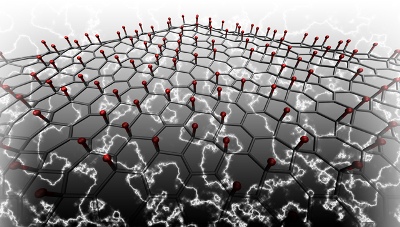Two materials engineers, Evan Reed and Mitchell Ong from the Stanford School of Engineering, have described a novel method of engineering piezoelectrics into graphene in a paper reported in ACS Nano.
 This illustration shows lithium atoms (red) adhered to a graphene lattice that will produce electricity when bent, squeezed or twisted. Conversely, the graphene will deform when an electric field is applied, opening new possibilities in nanotechnology. (Illustration: Mitchell Ong, Stanford School of Engineering)
This illustration shows lithium atoms (red) adhered to a graphene lattice that will produce electricity when bent, squeezed or twisted. Conversely, the graphene will deform when an electric field is applied, opening new possibilities in nanotechnology. (Illustration: Mitchell Ong, Stanford School of Engineering)
The work extends engineering control to the nanoscale for the first time. Reed explained that the created physical deformations proportionally vary with the applied electrical field, representing a novel approach to manipulate electronics at the nanoscale. This phenomenon offers new insights to the ‘straintronics’ concept for the manner the electrical field deforms or strains the carbon lattice, making the material to modify its shape in predictable ways.
Ong informed that piezoelectric graphene may offer an unprecedented degree of control over optical, electrical and mechanical properties for applications such as nanoscale transistors and touchscreens.
In order to measure the piezoelectric effect, the engineers used an advanced modeling application to simulate the doping process of graphene. They simulated graphene doped with fluorine, potassium, hydrogen, lithium and combinations of fluorine and lithium and fluorine and hydrogen on either sides of the graphene lattice. Doping graphene with atoms on one side or with different atoms on both sides is important to retain the piezoelectric effect in graphene because it modifies the perfect physical symmetry of the nanomaterial.
The researchers were surprised with the piezoelectric levels of doped graphene. Piezoelectric value in graphene was equivalent to that of conventional 3D materials, Reed said. Ong stated that the piezoelectric effect was fine-tuned by selectively depositing atoms in designated sections of graphene, a process called pattern doping. Since the piezoelectricity enables strategic control over the deformation of the nanomaterial by an applied electric field, it is termed as designer piezoelectricity by the engineers.
Based on the positive results from the fabrication of piezoelectric graphene, the engineers hope that their method to engineer piezoelectricity in other nanomaterials such as nanotubes for applications, including high-frequency acoustics, chemical sensing, energy harvesting, photonics and electronics.